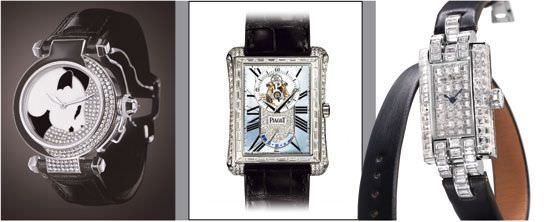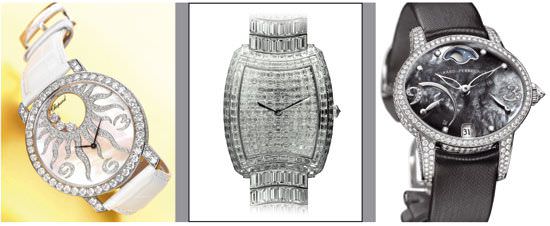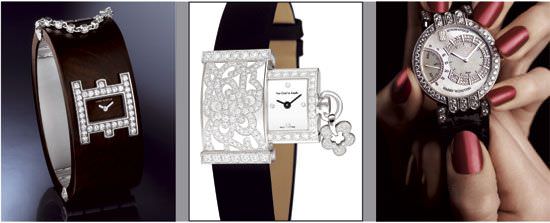Diamond watches are a certified Top Wesselton phenomenon in the watch industry. Many companies claim to have been the first to put diamonds onto a steel watch, but there's no denying that just about every watch company has followed in the same footsteps down the road to financial success.
As a result, watch retailers all over the world either have to get on board the diamond watch train or lose out on sales. If your customers can't find what they want in your store, they will go somewhere else to buy.
How do you know what's good quality in diamond watches and what's not? If you aren't a jeweller, chances are you don't know too much about diamonds, so here's a simple explanation that should help you spot the difference between a quality diamond watch and one of lesser quality.


PASHA by Cartier, EMPERADOR TOURBILLON HAUTE JOAILLERIE by Piaget and IDéALE JOAILLERIE by Jaeger-LeCoultre
Diamonds on watches
Diamonds are not just a trend anymore; they are a category all unto themselves. Some watch companies have been doing diamonds, and jewelled watches in general, for most of their history, while many other brands are new to the diamond game because diamonds are so hot. The bottom line is that, in women's watches, watches with diamonds sell faster and better than the same watches without diamonds.
Men are starting to buy some watches with diamond enhancements, though the watch completely covered with diamonds for men is still the exception rather than the norm. Rappers, hip-hop artists and other trendy male cel-ebrities are helping to fuel diamonds for men. Wearing ‘blinged’ watches in music videos, on the cover of music and lifestyle magazines and more has certainly upped the visibility, and acceptance, of diamond watches for men.
Eye candy
The way a diamond looks is a big indicator of its quality. If the diamonds sparkle and reflect light back, looking bright and white, the diamonds are probably pretty good.
If the watches you carry in your store are designed for the bling factor, customers prob-ably won't get too worried about the carat weight and the quality of the stones. If the watch is covered in diamonds, makes a statement, the diamonds look good and they love it, they'll buy it. Some of the diamond watches on the market are quite reasonable in price - just don't expect the highest quality diamonds.
When you are considering carrying a diamond watch line, or adding diamond watches to the selection you have now, you have to know enough to ask the right questions.
There is an internationally accepted grading system for diamonds. Jerry Ehrenwald, G.G., A.S.A., President and CEO of the International Gemological Institute (IGI) explains. “With one internationally accepted system for diamond grading, there is a means for everyone to understand the quality of the diamond they are considering purchasing,” he says. “In order to know where a particular diamond is on this system, a certificate from an independent laboratory like IGI is required. Here at the Institute, we certify a diamond by issuing a document called the Diamond Grading Report.
”There are the 4Cs of diamonds: the carat weight (objective), the cut (shape, proportion, etc. - somewhat subjective), colour (D, E and F means the diamond is colourless and G, H, I and J near colourless - subjective) and clarity,“he continues.”The grades for clarity are: FL is flawless, IF is internally flawless, VVS 1 and 2 are very very small inclusions, not visible to the naked eye, VS 1 and 2 very small inclusions, again not visible to the naked eye, SI 1, slight inclusions, not visible to the naked eye, and SI 2, slight inclusions sometimes visible to the naked eye, depending on the cut, I 1, I 2 and I 3 for imperfect, visible to the naked eye."


KALLA by Vacheron Constantin, HAPPY DIAMONDS by Chopard and CAT’S EYE RETRO by Girard Perregaux
According to Ehrenwald, a retailer who is selling diamond watches is supposed to tell the customer the diamond grade if they are able to. If they are not able to declare the quality, then customers can ask for an independent grading report from a credible laboratory using the internationally accepted system for diamond grading.
If you are going to retail diamond watches, you should be able to tell your customers the kinds of diamonds used on those watches. The problem is that most diamonds used on watches are small and sometimes may not even be graded at all. These diamonds are called melee, which are under 0.22 carat down to 0.0025 carat. Like other diamonds, melee diamonds can be either full cut (58 facets) or single cut (16 facets) and cover the range in quality. The cost of these melee diamonds ranges from relatively inexpensive, for poorly cut, poor quality stones, to very expens-ive for the best stones. For the poorest quality melee diamonds, the setting of the diamonds can cost more than the stones themselves.
“There are a lot of bad diamonds out there on watches,” admits Fred Cuellar, President/CEO, Diamond Cutters International. “If you are going for high quality, ask for full cut, VS, F or G and say that you want matched, calibrated diamonds. Matched means that all the little diamonds have the exact same diameter.”
If you want the highest quality diamonds on the watches you sell, be prepared to pay more. “Better quality diamonds are going to cost more money,” says IGI's Ehrenwald. “Anything in the SI 1 quality or better is good for a watch, because the consumer can't see the quality imperfections with their eyes.”
If you don't want to have to worry about the quality of the diamonds, you should carry the best brands that sell diamond watches - brands like Chopard, Cartier, Jaeger-LeCoultre, Girard-Perregaux, Piaget and others. “If you focus on the prestige brands, then you can be sure the quality of the diamonds is good,” advises Darrell Ross, CEO, President, Ross-Simons Jewellers (East Coast, USA). “There is a price to pay, but you are getting the brand and the assurance they are good diamonds. If you go into the non-prestige brands, they can run the gamut from good diamonds down to not so good diamonds.”
The choosing of the diamonds and the setting on the watch are two other important factors when it comes to diamonds on watches. Some companies expend a great deal of effort to get matching stones (colour and size) and the setting of these stones is an art form unto itself. Most high-end watch brands do a combination of CNC preparation and hand-setting, while some special watches are completely hand-set. On the low-end, most watches are completely machine set.
“If you look at the diamonds alone, it's important to know the total carat weight of the diamonds on the watch,” says Raphaël Bertschy, Product Development Director, Zenith. “The importance with small diamonds is to have a lot of diamonds and have a visual impact. We choose only diamonds that are VVS1. There are a few ways of setting - you can do it completely by hand, which is the most expensive way, or you can mix - the holes in the case are prepared by CNC machine and you set and finish by hand. Completely machine-set is usually for cheaper brands and it's mainly done in Asia.”
Chopard, which sets more than two million stones a year, hand-sets all their watches. “We are a modern manufacture but we use old-world craftsmanship when we set the diamonds - the brain, the eyes and the hands are the most important,” says Mathias Hug, Sales Representative and Graduate Gemmologist for Chopard. “The diamonds are all hand-set and they make sure that everything is aligned so that the diamond is 'tights and stocking proof' - it's extremely hard to do that.”


AVENUE BANGLE EBONY by Harry Winston, SECRET by Van Cleef and Arpels and the PREMIER Collection by Harry Winston
Diamond watches: not an investment
You have to be careful when selling a diamond watch, because your customers shouldn't look at buying a diamond watch as an investment. Unlike a diamond ring with a beautiful stone, which will most likely hold its value, the diamonds on watches have little value apart from the watch as a whole. It would probably cost more to take the diamonds off a watch than they would be worth on the resale market. A diamond watch is an emotional purchase, not a hedge against inflation.
The worth of diamonds on a watch for most people is that it makes the watch sparkle and shine and the watch makes a statement on the wrist of the person who is wearing it.
On the high-end, a diamond watch from a prestige brand will marry high quality diamonds with the best in watchmaking and the artistry of stonesetting.
The customer is always right
Buying a diamond watch is a personal choice. You have to ask your customers what they want from a diamond watch - do they just want the bling factor or do they care about the quality of the diamonds? Some of your customers will just want a watch that shines and a less expensive watch with lower quality diamonds may be perfect for that customer. It may be worthwhile to have a lesser quality diamond watch to compare to the higher quality watches - making it easier to up-sell the client.
Diamond watches are a solid segment in watches, not just a trend that comes and goes. Watch retailers who learn about diamond watches and can sell them knowledgably will have an advantage in the marketplace. If you aren't already pushing diamond watches, you should be.
Source: Europa Star October-November 2006 Magazine Issue




